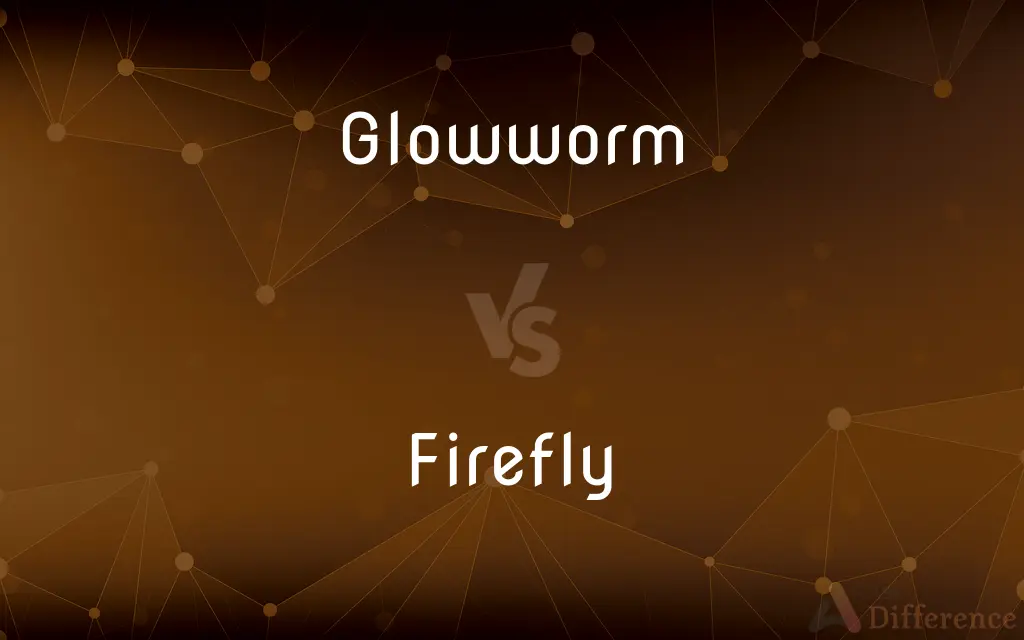Glowworm vs. Firefly — What's the Difference?
Edited by Tayyaba Rehman — By Maham Liaqat — Updated on February 27, 2024
Glowworms refer to various insect larvae and females of certain species that emit light, commonly found in caves or damp places. Fireflies are beetles known for their bioluminescent communication, seen in various outdoor spaces during twilight.

Difference Between Glowworm and Firefly
Table of Contents
ADVERTISEMENT
Key Differences
Glowworms encompass a range of bioluminescent insects, including larvae of both beetles and flies, as well as female beetles that cannot fly. The term often specifically refers to the larvae of the fungus gnat and certain female beetles. Fireflies, on the other hand, are a specific type of beetle belonging to the family Lampyridae. Both male and female fireflies are capable of producing light, which they use for communication purposes, including mating signals and territory establishment.
Glowworms are typically found in sheltered, moist environments like caves or dense forests, where their light attracts prey or mates. Their glow is a result of a chemical reaction within their bodies, primarily used for attracting prey or partners. Fireflies are most commonly observed in warm, humid environments and are known for their distinctive flashing patterns, seen in meadows, marshes, and gardens during the evening. Their bioluminescence is also a chemical reaction, but with the primary purpose of attracting mates rather than prey.
Both glowworms and fireflies use bioluminescence, the key differences lie in their species classification, habitats, and the purpose of their light production.
Glowworms' bioluminescence is often continuous, serving to lure prey or signal for mates in dark environments. In contrast, fireflies produce intermittent flashes of light as part of complex communication patterns, mainly for mating purposes.
Comparison Chart
Classification
Various insect larvae and some females.
Beetles in the family Lampyridae.
ADVERTISEMENT
Habitat
Caves, damp forests, and sheltered places.
Meadows, marshes, gardens, and warm environments.
Light Production
Primarily for attracting prey or signaling mates.
Mainly for communication and mating signals.
Visibility
Often in dark, moist environments.
Commonly seen in outdoor spaces at twilight.
Bioluminescence
Continuous glow.
Intermittent flashes with specific patterns.
Species Diversity
Includes larvae of beetles and flies.
Specifically beetles with diverse species.
Compare with Definitions
Glowworm
Bioluminescent insect larvae or females.
The glowworms in the cave created a stunning, star-like display.
Firefly
Produce light for mating signals.
Each firefly species has a unique flashing pattern to attract mates.
Glowworm
Emit light continuously in dark habitats.
Glowworms illuminate moist caves to attract their prey.
Firefly
Visible in warm, humid outdoor spaces.
Fireflies are a common sight in meadows and marshes during twilight.
Glowworm
Larvae of fungus gnats or beetles.
Glowworm larvae feed on fungi and decaying matter in their habitat.
Firefly
Beetles known for their bioluminescent communication.
Fireflies flashing in the garden signal the start of summer evenings.
Glowworm
Found in damp, sheltered environments.
Dense forests are home to glowworms, where they use bioluminescence to signal mates.
Firefly
Belong to the family Lampyridae.
Over 2,000 species of fireflies are found worldwide, each with distinct light signals.
Glowworm
Use light primarily for prey attraction.
The light from glowworms lures small insects into their sticky traps.
Firefly
Known for distinctive flashing patterns.
The synchronous flashing of certain firefly species creates a spectacular nighttime display.
Glowworm
Glowworm or glow-worm is the common name for various groups of insect larvae and larviform females that glow through bioluminescence. They include the European common glow-worm and other members of the Lampyridae, but bioluminescence also occurs in the families Elateridae, Phengodidae, and Rhagophthalmidae among beetles; as well as members of the genera Arachnocampa, Keroplatus, and Orfelia among keroplatid fungus gnats.
Firefly
The Lampyridae are a family of insects in the beetle order Coleoptera with more than 2,000 described species. They are soft-bodied beetles that are commonly called fireflies, glowworms, or lightning bugs for their conspicuous use of bioluminescence during twilight to attract mates or prey.
Glowworm
A bioluminescent larva or a wingless wormlike female of certain insects, especially fireflies and beetles of the family Phengodidae.
Firefly
Any of various nocturnal beetles of the family Lampyridae, characteristically having bioluminescent organs in the tip of the abdomen that produce a flashing light. Also called lightning bug.
Glowworm
The larva or wingless grub-like female of a beetle from the families Phengodidae or Lampyridae that gives out a green light from its abdomen.
Firefly
Any beetle of the family Lampyridae, which exhibit bioluminescence during twilight.
Glowworm
The luminous larva or wingless grub-like female of a firefly
Common Curiosities
What causes glowworms and fireflies to glow?
Both glowworms and fireflies glow due to a chemical reaction involving luciferin, oxygen, and enzymes, producing light.
Where can you typically find glowworms?
Glowworms are often found in dark, moist environments like caves or dense forests, where their light can be used effectively to attract prey or mates.
Can all glowworms fly?
No, many glowworms, especially the larvae and some females, cannot fly, in contrast to fireflies, where both gender usually can.
Why do fireflies flash?
Fireflies flash to communicate, primarily for mating purposes, with each species having its own unique pattern to attract potential mates.
What time of day are fireflies most active?
Fireflies are most active during twilight and early evening hours when their flashing lights are most visible.
Do all fireflies produce light?
While most firefly species are bioluminescent, there are some species where to do not produce light.
Can the light from glowworms and fireflies be different colors?
Yes, the bioluminescent light can vary in color from green to yellow to orange, depending on the species and the chemicals involved.
Are glowworms and fireflies found worldwide?
Fireflies are found in various warm and humid environments worldwide, while glowworms are more habitat-specific, thriving in damp, sheltered places.
How do glowworms and fireflies contribute to the ecosystem?
They play roles in pest control, pollination, and serve as food for other species, contributing to the biodiversity and balance of ecosystems.
How do glowworms attract their prey?
Glowworms use their continuous glow to lure in prey, such as small insects, into their sticky traps.
Is the population of glowworms and fireflies at risk?
Yes, populations of both glowworms and fireflies are at risk due to habitat destruction, pollution, and climate change.
What can be done to protect glowworm and firefly habitats?
Protecting habitats involves conserving natural areas, reducing light pollution, and limiting the use of pesticides that can harm these insects.
Are glowworms and fireflies the same species?
No, glowworms and fireflies belong to different species and families, with distinct habits, habitats, and purposes for their bioluminescence.
What is the purpose of a firefly's light?
The primary purpose of a firefly's light is for mating communication, though it can also serve to deter predators.
How do scientists study glowworms and fireflies?
Scientists study these creatures through field observations, laboratory experiments, and by analyzing their habitats and behaviors.
Share Your Discovery

Previous Comparison
Osteoplasty vs. Osteotomy
Next Comparison
Educated vs. IntelligenceAuthor Spotlight
Written by
Maham LiaqatEdited by
Tayyaba RehmanTayyaba Rehman is a distinguished writer, currently serving as a primary contributor to askdifference.com. As a researcher in semantics and etymology, Tayyaba's passion for the complexity of languages and their distinctions has found a perfect home on the platform. Tayyaba delves into the intricacies of language, distinguishing between commonly confused words and phrases, thereby providing clarity for readers worldwide.














































